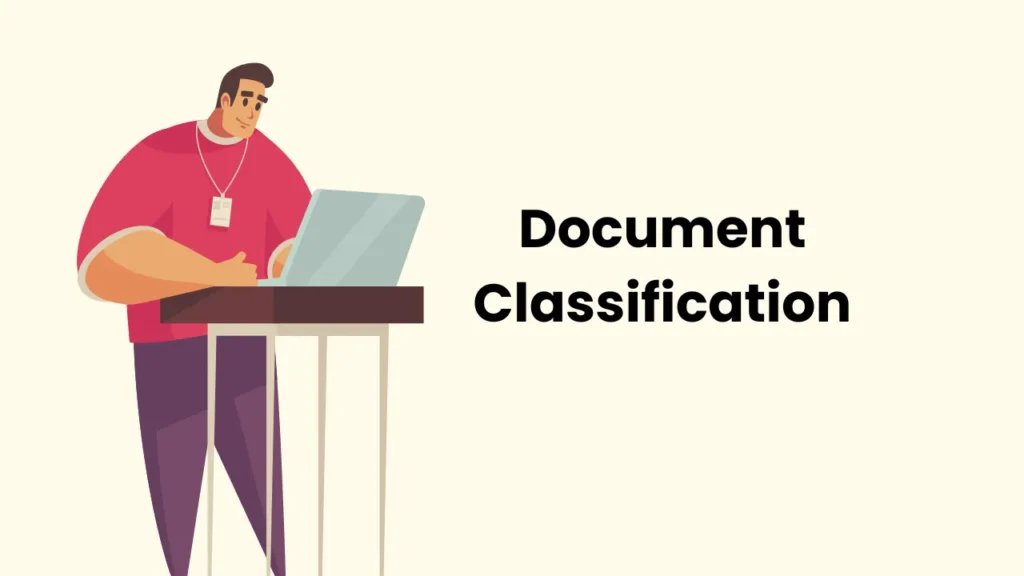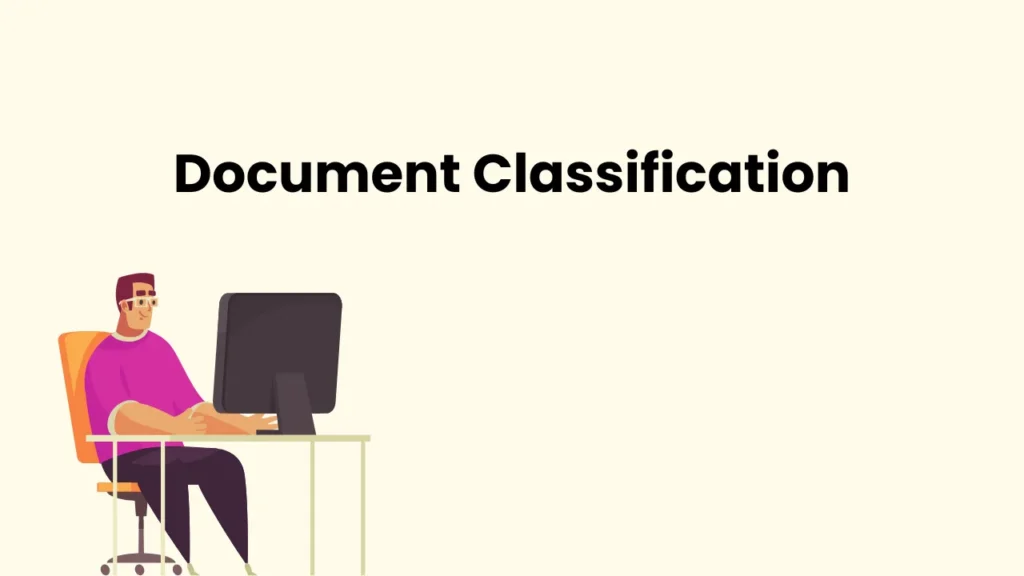Every day, organizations deal with large amounts of documents that vary in type, content, and importance. As a consequence, maintaining an accurate classification of these files can become frustrating, in particular when it is done by hand. Some of your employees are in charge of manually organizing documents based on these labels.
This takes time, and in the worst case, the files disappear because they are incorrectly classified. Fortunately, employees no longer have to spend excessive time labeling documents because automation has taken over these tasks.
Let’s get started with this blog post, which provides a detailed explanation of what AI document classification means, an overview of the automation process, and an innovative solution for classifying your business documents.
To avoid AI detection, use Undetectable AI. It can do it in a single click.
Document Classification

Assigning documents to appropriate categories for convenient management and analysis is known as document classification. To facilitate simpler searching and item retrieval, files should be appropriately organized.
Classifying documents is a necessary activity in and of itself, but it is a component of a larger automation project known as intelligent document processing. Thus, among the several tasks that can be automated to enhance document processing workflows is categorizing these files.
Text and visual classification are the two characteristics that can be used for document categorization. Users can locate what they are searching for with minimal trouble due to some of these factors, which are visible in actual search engines.
It is necessary to take a step back and examine the technological procedure underlying automated document classification in order to gain a better understanding of how document categorization can occur.
Types of Document Classification

Documents are categorized based on their content, whether it be text or image, as mentioned earlier. We go over several techniques in a moment that are used to identify and examine the particular content for each type of document classification.
Image Classification
The visual organization of documents is the main focus of image categorization. In order to identify images and videos within a document, primarily the content of the visual is ascertained by examining the pixels that compose up the image.
Computer vision and object detection are two examples of the technologies used in the identification and classification of images. AI-powered computer vision technology can identify things in still images or motion pictures.
It can be used to identify items inside an image, where they are located within a document, or the activity that is shown in the visual content. Through the use of filters and search functions, computer vision assists with image classification.
Object detection is used in business domains where managing vast volumes of visual data and large-scale classification are priorities. Object detection, for example, is used in inventory, warehousing, and logistics departments where scanning barcodes and QR codes is a regular aspect of business.
Text Classification
Processing text from different document kinds is the focus of text classification. Since organizations rely on documents with considerable amounts of text for routine tasks, text categorization has taken center stage for software suppliers, including OCR software.
Machine learning technologies such as OCR and NLP are used in text classification applications. With the aid of OCR technology, text can be extracted from images or scanned documents and transformed into a format that is readable by computers.
In order to obtain high data extraction accuracy, this technique is used with both machine learning and artificial intelligence. NLP is a sophisticated method that is in charge of deciphering the text’s semantics and doing additional analysis on the data that has been retrieved.
NLP enables computers to comprehend human language within a particular context, resulting in a high-quality, high-accuracy data extraction procedure. In order to classify a document automatically, information should be initially extracted using OCR, and then the content should be understood using NLP.
Techniques of AI Document Classification Using Machine Learning

Machine learning is used to accomplish the AI document classification. It uses natural language processing, requiring an extensive amount of data to train on in order to accurately recognize and categorize patterns in documents.
We provide the model pre-existing data, which has predefined feature sets and classifications, in order to train it. The model can now learn statistical relationships between words and phrases as an outcome.
Machine learning classifiers gather textual input that can be used to extract keywords and construct categories for the model to learn from, such as essays, articles, and other types of text. But there are other approaches to use machine learning to classify documents.
Supervised AI Document Classification
When using supervised document classification, you train the model on documents that have a label since you supply the input. As a consequence, the categorization process involves assessing how the newly created document and the tagged historical data relate to one another.
For instance, you can practice by feeding it sample bank statements, receipts, and invoices. These kinds of papers can be easily identified and categorized by the model. However, attempting to categorize identity papers using the model can result to an unsuccessful outcome.
Because the model was unable to establish a connection between the newly created documents: identity documents and the previously classified data invoices or receipts, the categorization turned out to be erroneous.
Pros of Supervised AI Document Classification
- It is a precise document classification.
- It is simple to assess its outcomes.
Cons of Supervised AI Document Classification
- A sizable training dataset is necessary.
- The training set or considerable amount of data labeling might be costly and time-consuming.
Unsupervised AI Document Classification
A training dataset is not necessary for the unsupervised AI document classification process to learn from. Its goal is to categorize papers by examining their content and identifying patterns among them. After that, the sorted documents are arranged into clusters, or categories, by the model.
Even though several papers might appear similar, the model does not know which categories they belong to, therefore there is room for error on the precision of the classification.
Pros of Unsupervised AI Document Classification
- It does not require a training dataset with labels.
- Because there is no need for labeling, it is quicker and less expensive to use.
Cons of Unsupervised AI Document Classification
- It is challenging to assess.
- Compared with the supervised technique, it is less accurate.
Semi-Supervised AI Document Classification
Combining supervised and unsupervised classifications results in semi-supervised AI document classification. Using both labeled and unlabeled training datasets, it enhances the efficacy of both classification techniques without attaining perfection in either of them.
Pros of Semi-Supervised AI Document Classification
- Increases the precision of both categorization techniques.
- It needs less training data than supervised classification.
Cons of Semi-Supervised AI Document Classification
- It is challenging to put into practice than both the supervised and unsupervised approaches.
- It might not be as precise as supervised classification.
How Can Documents Be Classified Automatically Using AI Document Classification?

Deep learning, a subset of machine learning, is used in AI document classification to automatically categorize files into different categories without the need for human input. You follow a straightforward, three-step procedure for this process, which is as follows:
Compile a Dataset
The initial step in training the classification model is data preparation. This entails obtaining a minimum of 20 documents per category, or 20 data points per label. This improves output precision and produces a high-quality final product. Based on the particular data that it was trained on; the algorithm classifies the output.
For example, it would sense to train the model on several invoices if you wanted to classify just invoices. However, the model can have trouble correctly identifying your intended documents if you want to categorize a different document type, such as a receipt.
Training the Model
Depending on the classification method you select: supervised, unsupervised, or semi-supervised: this process could get costly and time-consuming. Even though it is a repetitious task, it is required to obtain the precise results.
Assess Outcomes
It is necessary to check if the model is operating as you anticipated by comparing the outcomes to your expectations. This can be achieved by providing correct representation in the comparison by benchmarking the classification results against a document that has already been predicted.
Take as much time as you need in order to comprehend this process. Long-term difficulties can only occur if you rush to provide the model with erroneous data or insufficient data points.
Benefits of AI Document Classification For Businesses

AI document classification enables your company to implement daily business activities smoothly. Among the advantages of putting this technique into effect are:
- You can save an extensive amount of time and money by using AI document classification to organize and analyze vast amounts of information.
- When papers are automatically classified, anomalies or human error in these files are used to detect fake documents. Therefore, automation aids in the reduction of document fraud in your company, including invoice fraud.
- Manual document classification can quickly become perplexing. This can lead to mistakes and imprecise decisions. This problem is resolved by automatic categorization, which sorts or even indexes the documents according to categories that you and your team have specified.
These advantages might not seem significant in the beginning, but they can have a significant impact on how you run your company. In order to gain a better understanding of this issue and to view a broader context, let’s talk about some actual applications of AI document classification.
Use Cases and AI Document Classification Applications

To comprehend the usage of document classification, one should be aware of the theory underlying it. Here are some examples of how AI document classification might benefit your company:
Digitization of Documents
It is possible that your company handles a variety of documents, such as contracts, invoices, and receipts. Your procedures can be streamlined by using document scanning software to scan the document, digitize it, and label it through categorization.
Enabling Client Assistance
Customer service staff can distinguish between claims, refunds, questions, and other remarks based on the language by using AI document classification. Through the designated departments receiving the necessary remarks, workflow efficiency is increased.
Handling Client Feedback
Positive and constructive comments can be distinguished by analyzing the text’s semantics and tone, which we found is accomplished using natural language processing.
As a consequence, suggestions for bettering business procedures are easily accessible to your corporation, enabling you to provide superior customer service.
Email Spam Detection
Emails that fit into the spam category can be found with the aid of AI document classification. Compared to typical emails, they contain strange-sounding material, grammatical or spelling problems, and other issues that cause suspicion.
Emails that check these boxes are retrieved in the associated spam inbox using AI document classification, protecting your company from malicious links and unsolicited correspondence.
Conclusion: AI Document Classification
In the digital age, where vast amounts of data are generated daily, the need for efficient document management is necessary. AI document classification has emerged as a powerful solution, leveraging advanced machine learning algorithms to automate the sorting and categorization of documents.
This technology not just streamlines workflows but enhances productivity by reducing the time spent on manual data entry and organization. By analyzing the content of documents, AI systems can accurately classify them into predefined categories.
From legal firms managing case files to healthcare organizations sorting patient records, AI document classification is transforming how we handle information.
As organizations adopt AI-driven solutions, understanding the intricacies of document classification is necessary for harnessing its potential in optimizing operations and driving innovation.
FAQs: AI Document Classification
What is AI Document Classification?
AI Document Classification refers to the use of artificial intelligence techniques to automatically categorize and organize documents based on their content. This process involves analyzing the textual or visual elements of a document and assigning it to a specific document type or classification model.
By leveraging machine learning algorithms, organizations can manage large volumes of data, streamline document processing, and improve information retrieval.
How does document classification work?
The process of document classification involves several steps. In the beginning, a training data set is prepared, consisting of labeled examples of various document types. This data is then used to train a classifier, which learns to identify patterns and features that distinguish different categories.
Once trained, the machine learning model can classify documents by analyzing new documents and assigning them to the appropriate categories based on learned patterns. This can be done using various techniques, including supervised document classification and unsupervised document classification.
What are the benefits of using AI document classification?
Automated document classification offers numerous benefits, including increased efficiency, reduced manual effort, and improved accuracy. By automating the classification work, organizations can process large volumes of documents quickly, freeing up human resources for complex tasks.
Intelligent document processing can lead to consistent and accurate classification uses, minimizing errors that may occur with manual document classification. This can result in better decisions and enhanced productivity.
What types of document classification techniques are available?
There are several document classification techniques that can be employed, including text classification, image classification, and visual classification. Text classification focuses on analyzing the textual content of documents, while image classification deals with visual elements.
Other methods include supervised document classification, where labeled data is used for training, and unsupervised document classification, which identifies patterns in unlabeled data. Depending on the specific needs, organizations may choose a custom document classifier tailored to their unique document types.


